- About us»
- Net income calculator»
- Population aging»
-
- Least developed regions»
-
- Average wage
- Material need benefits
- Meal allowance
- Counties of Slovakia
- Inflation
- Living and Subsistence Minimum
- Unemployment of Czechia and Slovakia
- NACE Classification
-
- Life expectancy
- Gender differences
- Youth unemployment and NEET
- Minimum wage in EU
- Unemployment rates of different age groups
- Share of salaries on GDP
- Percentage of employees ususally working at nights
- Unemployment rate
- NEET
- Long term unemployment
- Employment rate
-
- Bratislava and surroundings
- Kopanice
- Danube river
- lower Vah river
- middle Vár river
- upper Nitra river
- lower Nitra river
- Mining cities
- Kysuce a Orava
- upper Vah river - Liptov
- Spiš cities
- upper Hron river
- Juhoslovenská kotlina
- Košice fold and Torysa river
- upper Zemplín
- lower Zemplín
- EU regions
- NUTS3 regions of Slovakia
- LAU1 dataset
-
- Projects and activities
- Inclusive growth»
- Good work
- Project SKRS
- Social system – reality and vision
- Library
-
- Education of unemployed
- Young unemployed not taking part in education
- Proposal to change the system of education funding
- News»
- Contact
Burgundy – FRC1
EU regions: France > Bourgogne-Franche-Comté > Burgundy
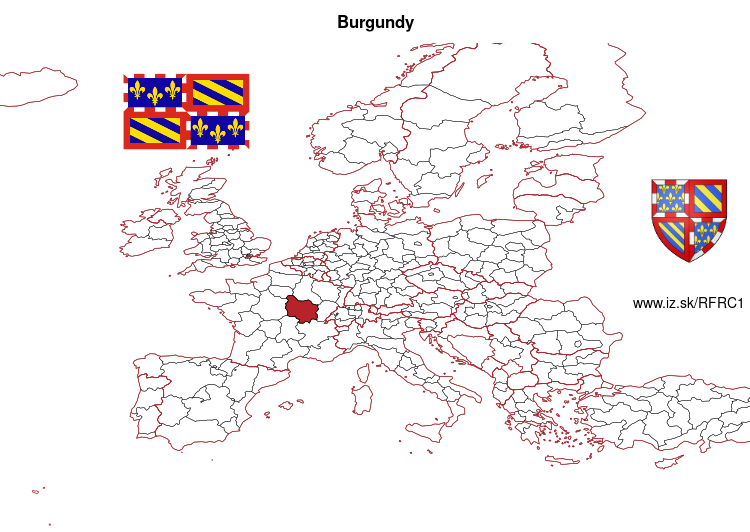
| Indicator | Period | Value |
|---|---|---|
| Life long learning | ||
| life long learning participation | 2024 | 13.3 |
| Part time jobs and flexible employment | ||
| percentage of part time workers | 2024 | 20.4 |
| percentage of part time workers, men | 2024 | 9.8 |
| percentage of part time workers, women | 2024 | 31.35 |
| Gender differences | ||
| gender gap in employment rate | 2024 | 94.83 |
| gender gap in unemployment rate | 2024 | 86.11 |
| Graduates and young people | ||
| unemployment rate of youth with elementary education | 2023 | 31.6 |
| NEET | 2024 | 11.1 |
| Gross domestic product | ||
| GDP per capita in PPS of EU average | 2023 | 82 |
| Employment | ||
| employment rate | 2024 | 67.8 |
Burgundy slovensky: FRC1
Subregions: Côte-d’Or, Nièvre, Saône-et-Loire, Yonne
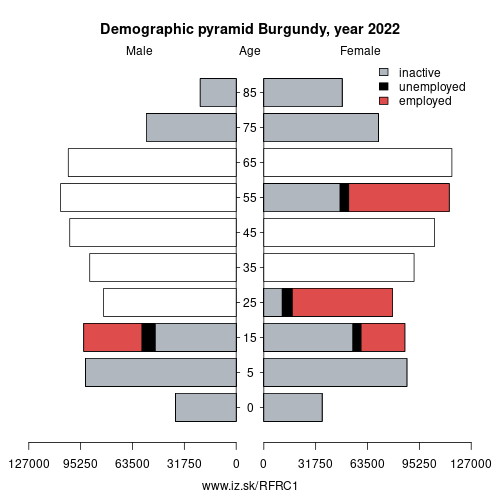
Unemployment
| Indicator | Period | Value |
|---|---|---|
| Unemployment | ||
| unemployment rate | 2024 | 6.9 |
| youth unemployment rate | 2024 | 17.7 |
| Long term unemployment | ||
| long term unemployment | 2024 | 1.5 |
| share of long term unemployed | 2024 | 22.4 |
Demographics
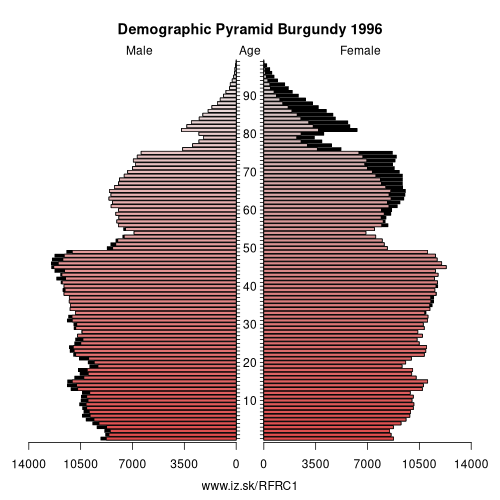
| Indicator | Period | Value |
|---|---|---|
| Demographics | ||
| number of inhabitants | 2024 | 1 617 648 |
| population density | 2023 | 51.3 |
| old-age dependency ratio | 2024 | 44.3 |
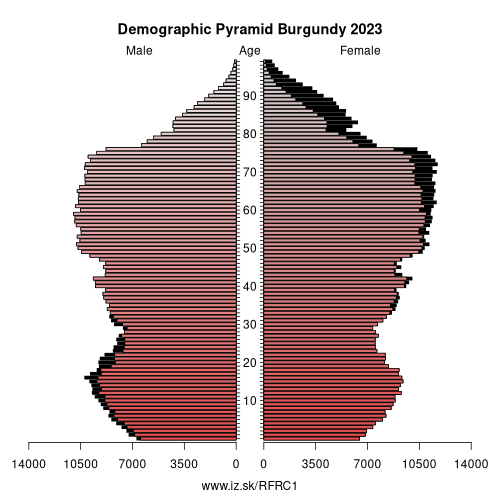
Employment by sectors, Burgundy
| NACE r2 | % | NACE r2 | % | ||
|---|---|---|---|---|---|
| A | 28.8 | 5% | B-E | 89 | 14% |
| F | 41.5 | 6% | G-I | 132.3 | 21% |
| J | 8.1 | 1% | K | 17.2 | 3% |
| L | 5.2 | 1% | M_N | 55.7 | 9% |
| NRP | 15.5 | 2% | O-Q | 219.8 | 34% |
| R-U | 26.3 | 4% | TOTAL | 639.3 | 100% |
Data for the period year 2024. Source of the data is Eurostat, table [lfst_r_lfe2en2].
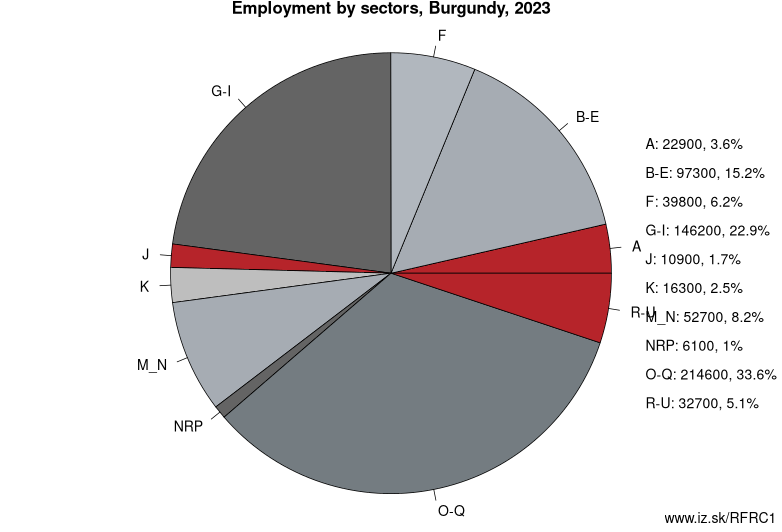
From Wikipedia :
Burgundy (; French: Bourgogne [buʁɡɔɲ] (listen)) is a historical territory and a former administrative region of east-central France. It is named for the Burgundians, an East Germanic people who moved westwards beyond the Rhine during the late Roman period.The name Burgundy has historically denoted numerous political entities, including kingdoms and duchies spanning territory from the Mediterranean to the Low Countries. Since the inception of the French departmental system in 1790, Burgundy has referred to the geographic area comprising the four departments of Côte-d'Or, Saône-et-Loire, Yonne, and Nièvre.
In 2016, Burgundy and the historical region of Franche-Comté merged for administrative purposes into the new region of Bourgogne-Franche-Comté.
History
The first recorded inhabitants of the area that became Burgundy were various tribes of Gallic Celts, the most prominent of which were the semi-republican Aedui who were eventually incorporated into the Roman Empire following the defeat of the Gauls in the Battle of Alesia. Gallo-Roman culture flourished during the Roman period.
During the 4th century, the Burgundians, a Germanic people who may have originated on the Baltic island of Bornholm, settled in the western Alps. They founded the Kingdom of the Burgundians, which was conquered in the 6th century by another Germanic tribe, the Franks.
Under Frankish dominion, the Kingdom of Burgundy continued for several centuries.
Later, the region was divided between the Duchy of Burgundy (to the west) and the Free County of Burgundy (to the east). The Duchy of Burgundy is the better-known of the two, later becoming the French province of Burgundy, while the County of Burgundy became the French province of Franche-Comté.
Burgundy's modern existence is rooted in the dissolution of the Frankish Empire. In the 880s, there were four Burgundies: the duchy, the county, and the kingdoms of Upper Burgundy and Lower Burgundy.
Other: Bourgogne-Franche-Comté, Burgundy, Franche-Comté
Neighbours: Franche-Comté, Champagne-Ardenne, Auvergne, Centre-Val de Loire, Rhône-Alpes, Île-de-France
Subregions: Côte-d’Or, Nièvre, Saône-et-Loire, Yonne
Suggested citation: Michal Páleník: Europe and its regions in numbers - Burgundy – FRC1, IZ Bratislava, retrieved from: https://www.iz.sk/PFRC1, ISBN: 978-80-970204-9-1, DOI:10.5281/zenodo.10200164

 Share
Share Facebook
Facebook Twitter
Twitter News
News